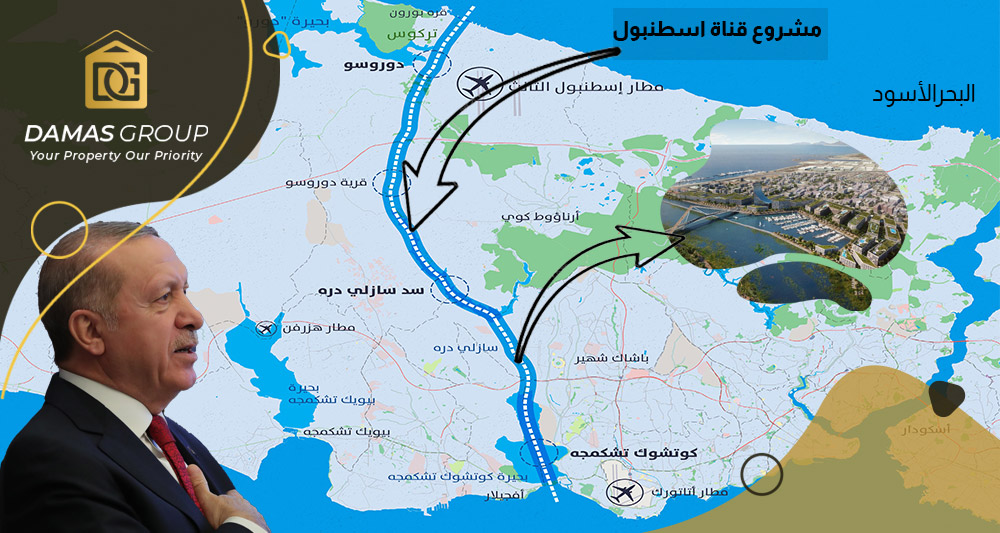
Turkish President Recep Tayyip Erdogan announced that by the end of 2017 or early 2018, the most ambitious part of Kanal Istanbul project, the so-called "Crazy Project", an artificial waterway at sea level, would change the scene of the city. This project has the role to increase and open new opportunities for real estate investment in Turkey and the prices of apartments will apparently rise in Istanbul. Currently, there is much concern about choosing the routes that might have the least impact on the environment, freshwater resources and lands used for agriculture, as well as the procedures of laying the foundations.
When Did the Work on Istanbul Canal Begin?
- The work started in 2013 where up to now 16,2000 holes and wells have been drilled and the foundations of 43 km (26 miles) have been laid. Freight ships will be diverted away from the Bosporus route due to excessive traffic. The canal is just one of many mega-projects in Istanbul which also includes the largest airport in the world that is expected to open in 2018.
- The artificial canal between Marmara and the Black Sea will be 25 meters deep and 145 meters wide. The canal was first unveiled in 2011 immediately before the general elections. Upon the completion of Istanbul Canal project which costs $15 billion, Istanbul will have a new island, a new city and six bridges that will direct traffic over the canal and the project is expected to end in 2023.
- The idea of Istanbul Canal has emerged from the need to overcome and stop the excessive traffic in the Bosporus Strait which is threatened by the danger of pollution and rapprochement between ships. About 56,000 vessels pass yearly through the Istanbul Strait, among them 10,000 tankers carrying 145 million tons of crude oil.
- What are the areas from which the Istanbul Canal will pass؟
- This project is considered an alternative route to the Bosphorus Strait within the boundaries of the regions of Avgilar, Kuchuk-Chikmega, Bashak Shahr, and Arnaout-Koe on the European side of the city. All infrastructure and superstructure will be built within the scope of the project that will be within the boundaries of these areas.
- After having the approval of the Environmental Impact Assessment (EIA) report submitted to the Ministry of Environment and Urban Planning, the process of environmental impact assessment of the project was initiated. As a result of the studies conducted in accordance with the data of the EIA request file, the most appropriate path among five alternative methods was identified. Accordingly, the project will begin from the isthmus that separates the Marmara Sea from the Kuchuk-Chikmaje lake which runs along the Sazledere dam basin and passes through the village of Szelebosna in the east of Dorsonkoy, and the village of Baklali and eventually reaches the Black Sea in the east of Lake Turkus.
- About 7 kilometers of the canal route will be located within the boundaries of Kuchuk-Chikmega, about 3.1 kilometers within the boundaries of Aghjalar, approximately 6.5 kilometers within the boundaries of Pakak Shahir region, and the rest 28.6 kilometers will be within the boundaries of the Arnaout-Kui region.
The reaction of local people to the construction of the Istanbul Canal :
Local residents show much interest in real estate, especially by large companies and Arab buyers. The Turkish Ministry of Transportation confirmed that the residents of Baklali and Dorskoy villages will not be affected by the project, but they are a bit worried as the construction of the new Istanbul airport led to selling more than 75% of te local lands that investors own besides the hinders they faced from villagers who stick to their rural lifestyle, so they are afraid of the future and believe that many of old residents will not be able to adapt to residential life in luxury housing.
Some locals and the World Wildlife Fund (WWF) are also concerned about the environmental impact of the project and what the urban landscape will look like when the project ends. The WWF has urged experts to undertake further research in this area.
Real Estate Price Index in Istanbul :
In June 2017 the Anatolia National News Agency reported that the prices of apartments in Istanbul have increased with the announcement of the project. Sahibinden, the leading website for apartments on sale in Turkey, reported that there is an abnormal real estate activity in the neighborhoods of Arnavutköy, Başakşehir, Küçükçekmece and Esenyurt. Sahibinden considered these areas promising places of investment in Istanbul.
In May 2017, the sale in Pakak Shahir reached a record price of TRY 3,458 per square meter on the real estate index in Turkey, while the price in Küçükçekmece reached more than 50% or TRY 3,375 per square meter. Arnaout also recorded an increase of more than 50% per square meter and the sale price of the meter reached 2170 Turkish lira, and in some other areas the rent increased to 125%.
Istanbul Canal Facilities :
- It is expected that there will be 5,000 people working in the construction phase and 1000 people in the project operation phase. The Canal will be built with an investment of TRY 60 billion ($ 15.6 billion). At the same time, engineering details will extend to 45 kilometers of the project. The road, which will pass through Lake Kuchuk-Chikmega, Sazelidere and East Lake Turkus, is expected to be completed within five years and its economic life will last for 100 years provided that maintenance is considered.
- Public meetings will be held on dates set by the Ministry of Environment and Urban Planning to inform the public about the investment and to listen to their views and suggestions regarding the project. The meetings will be held in the central areas that will be most affected by the project.
- The Black Sea container port, which was agreed to be established with the canal to the east of the northern entrance of the Istanbul Canal, will compete with Istanbul Airport, the third largest airport in the world.
- As part of the Istanbul Canal project, three islands, two to the left of the Canal towards the Black Sea and one to the right, will be built using excavation materials. There are also plans to build infrastructure and superstructure, such as ports, sea docks, fortifications and lines, Canal emergency berths, entrance and exit of the canal, as well as shipping systems.
 EN
EN  AR
AR  FA
FA  RU
RU  FR
FR 
 TRY
TRY  USD
USD  EUR
EUR  GBP
GBP  SAR
SAR  IQD
IQD  AED
AED  KWD
KWD  OMR
OMR  QAR
QAR  BHD
BHD  JOD
JOD  DZD
DZD  YER
YER 
